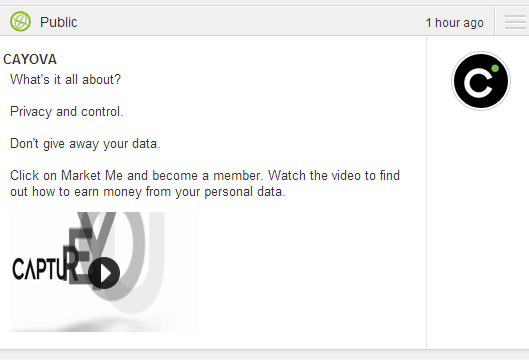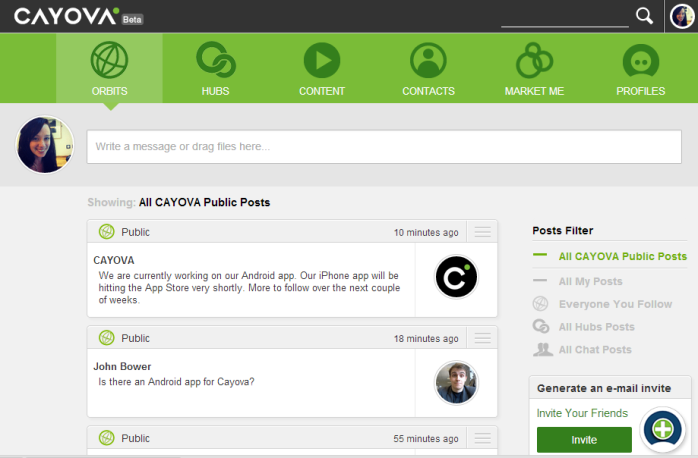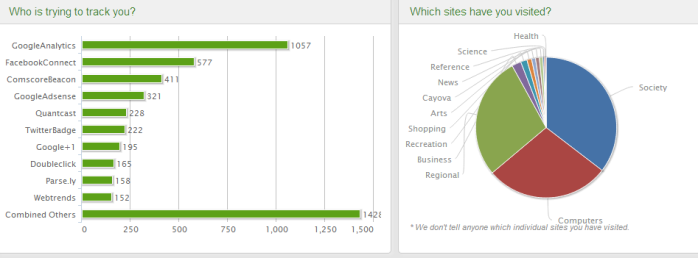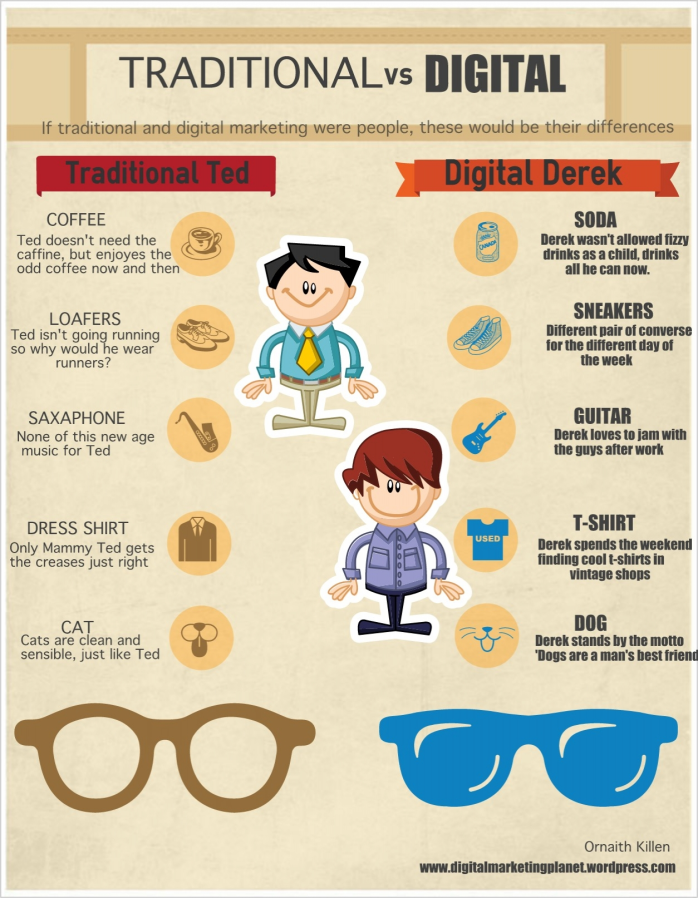
Cayova Logo
Beta Testing
The Beta site for Cayova.com went live on 29th April 2013. They describe themselves as a ‘revolutionary’ new platform, connecting users through social media. Cayova is a Facebook-style social network with two powerful privacy-related features. With one download, Cayova members can block ads as well as advertising networks trying to gather information about their online searches. Cayova also allows members to set up multiple profiles — for relatives, work colleagues, friends and “the public,” for instance — and control which groups see which posts.
Cayova believe in user empowerment; the right to privacy and the right to capture value. The user can choose what’s private and what’s public, or if they want to communicate in an open space or a private hub. It is also possible to make money from online activity. It’s all about choice. Cayova see themselves as a new way to engage with friends, a new way to share, and a new way to have private conversations with a selected few or a great many. Or indeed as a new way to capture your value.

Cayova Security
I decided to take part in this beta testing solely for the security ‘perks’ that Cayova claim to have over other social networking sites. I have been getting more and more unsatisfied with Facebook as time has gone on, as they keep changing their settings. In the past few months on Facebook I had changed all of my settings so that no one could search for me unless they were friends with me, see my photos, posts, and no one could tag me or post anything on my wall without my approval. Just in the last few weeks I have noticed that I am not getting notifications anymore for tags or posts, that Facebook have changed yet again, and I haven’t been told. As I become more educated in digital marketing and social media, I have come to appreciate the value of privacy and don’t want this to be an issue. I don’t want to delete my Facebook either, as I keep in touch with many friends that I met on my travels this way. So as a result, I wanted to try out Cayova and see what a secure social network is like.
Competing against Facebook is going to require an enormous investment as 67% of online American adults are Facebook users, compared with 20% who use LinkedIn and 16% who use Twitter. However, due to recent reports shown that teenagers “have waning enthusiasm” for Facebook, and that social-networks are increasingly seen as a burden, may give Cayova a fighting chance. A number of reasons cited for the decreased enthusiasm in Facebook including an increasing number of adults on the site, the annoyance of friends sharing inane details, and the stress associated with managing an online reputation while keeping up with online drama. More teenagers were also turning towards Twitter. Although attracting a far smaller crowd than Facebook, the micro blogging service increased its teenage user-base from 16 per cent in 2011 to 24 per cent in 2013.
I received a great value in studying Cayova, as it has educated me towards the importance of privacy in social networking. People have personas online, sometimes many different ones, and it is important to portray that though a social network. Consumers want different groups of people to see then in different lights, and this is a perfect network for allowing certain information for friends, work colleagues, or family. I would certainly like to see the social network get launched officially and how far it goes. I think I will continue using it just to see. This network is perfect if you only wish to use one social network. Coming from the hospitality industry where hardly anyone uses LinkedIn meant that I had to stay in touch with them over Facebook, including MDs and CEOs. However, Cayova is the network site to combat that, as I don’t wish to stay in touch with these people on a professional level anymore due to changing industry, just a personal one.
I had heard of Cayova through a close friend who was trying to win them for a business contract. I had a look on the site and after signing up, my initial thoughts were that the colour is similar to Vine and the layout is similar to Google+. The similar characteristics for the layout are the simplicity and the icons, as seen in the screen grabs below.

Cayova Profile
With Cayova, it is possible to have several different profiles for the different groups of friends. From their prospective, a user can have a school profile, a work profile, a public profile as well as a personal profile. From my perspective, however, it appears that ‘trolling’ will now become easier as the person will not have to log out of one account and log back in, all of their fake profiles will be under the one log in. It seems quite unsafe to do this, as a user can then have many different identities, and therefore is a possibility for easier trolling.

Cayova Fake Profile
As part of the experience, I took part in a ‘Feedback Hub’, a community specially created by Cayova to acquire and monitor feedback on their social network. After monitoring and interacting in this hub myself, I realised that there is only really one person giving feedback to Cayova, and in turn being interacted with the company themselves. The company are, however, excellent at keeping track of the comments and suggestions and are continuously changing the system to keep up with the suggestions.
Market Me
Cayova has a Market Me section that wants users to stop giving away data for free. Cayova is all about privacy. The first page to the Market Me section brings up a box, explaining that Cayova helps to get its members profit from their personal data. After opting into personal advertising on the site, a user can earn up to 50% of the ad’s earnings. A bonus scheme is also in place where members are rewarded for taking part in the ‘Market Me’ activities.
To begin this process, the user must install a box in the web browser to block trackers from third party companies. This extension stops third parties from installing cookies or tracking technologies from tracking the users browsing, and essentially from selling details without consent. Cayova have Terms and Conditions for participating on the network, including staying active.
After a small period of time the Cayova box has been busy as I browse. I typically wouldn’t vary in the sites that I visit, with them whittled down to social media, news, entertainment and academic. The only sites that vary are the academic ones, as I research whatever topic I am studying at the time.

Cayova Tracking Monitoring
It appears that Google Analytics is the worst offender, tracking me over 1057 in a matter of weeks. With the Google trackers combined, they account for over 32% of my tracking. The Facebook tracking should be higher, but I deactivated my account half way through this study.
A technology called ‘The Rapid Information Overlay Technology’ (RIOT) has been developed to track people though social networking sites. This software uses location data embedded in photographs and other Internet postings to track users’ movements and personal activities. Repeated “check-ins” or postings on social media sites leave a trail of location data that enables RIOT to build up a detailed daily itinerary for the people it is tracking. RIOT shows the frequency of check-ins and postings from particular locations organized as pie and bar charts. It is currently a “proof of concept” design that they are working on with industry, national labs and commercial partners to help turn massive amounts of data into usable information to help rapidly changing security needs. The innovative privacy features of the software enables the sharing and analysis of data without personally identifiable information, like social security numbers or bank account information, being disclosed.
Ads
Cayova ask if the user would like to participate in seeing ads, and allows the user to decide what types they see, and how many a day. Strangely, the ads do not show up on the side of the screen like they do on other sites. There is a special tab for Advertisements that the user can go into and watch the ads as they please. This is quite a unique concept, as usually the user is bombarded with information on other sites such as Facebook and Google.
According to Cayova’s terms of use, the company gives a user half of any payments it receives for ads “targeted at you or for access to your content and data,” minus sales taxes and transaction costs, such as bank fees. Users then have the option of donating that money to charity, receiving a check or deducting that amount from their mobile phone bill.

Cayova Ad Earnings
In 2012 in America alone, people spent $170 billion on direct marketing of both the physical and electronic varieties. Yet of those who received unsolicited adverts through the post, only 3% bought anything as a result. However, if the ad arrived electronically, the take-up rate was 0.1%. For online adverts the “conversion” into sales was a minuscule 0.01%. That means about $165 billion was spent not on drumming up business, but on annoying people, creating landfill and cluttering spam filters. However, this information comes as a surprise seeing as how targeted online marketing can be. Cayova, with their optional ads, seem to have the right idea, although it remains to be seen how their theories pan out.
However, Cayova’s ads section will now have to compete with Twitter’s new expansion, who are expanding their year-old Twitter Cards program giving marketers a new way to directly obtain interested business leads via the social media service. The new Lead Generation Card is squarely aimed at business tweeters, allowing marketers to embed a card within a standard Twitter message, generally promising some sort of promotional offer. When readers expand the tweet by clicking on the embedded link, they’re prompted to send their information to you, using the contact details from the user’s Twitter account.
Overall, I’d like to see where Cayova goes with the final version of their network. They have some interesting areas that differentiate them from other social networks, and it would be good to see where they take them. I think at the moment they need to perfect their website and build up their users, but it is questionable on whether they will get far or not.








